Forestry Administrative Official Hunting Cutlass by C. Eickhorn
CATEGORY: Version
SKU: 75.GOR.04.01.02.002.000
Estimated market value:
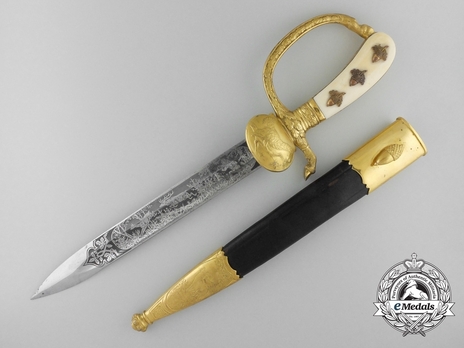
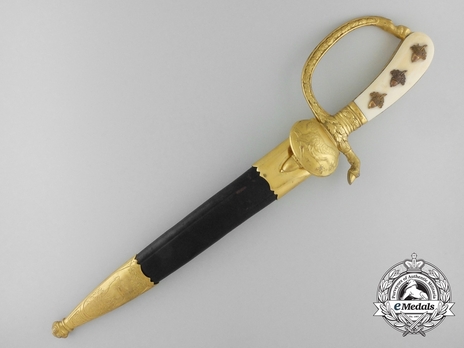
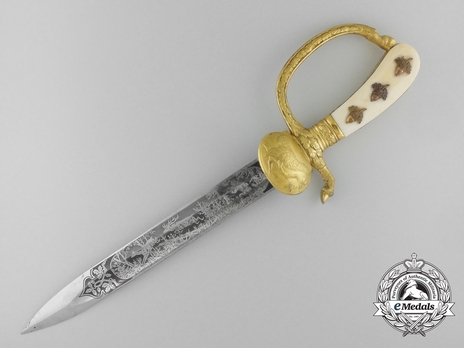
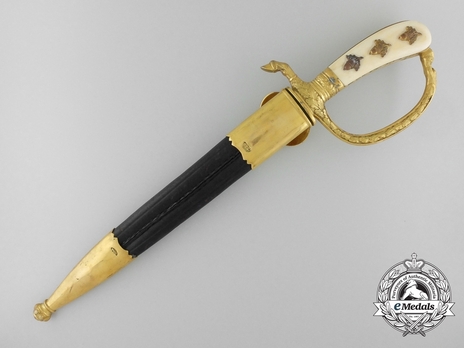
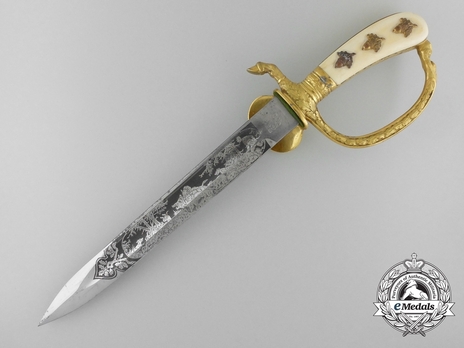
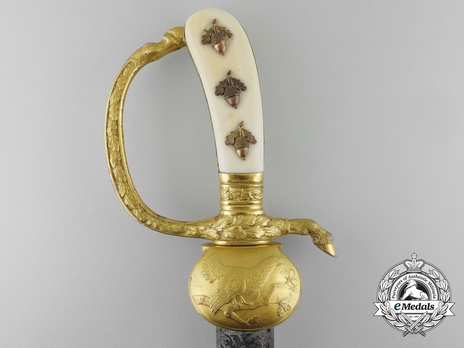
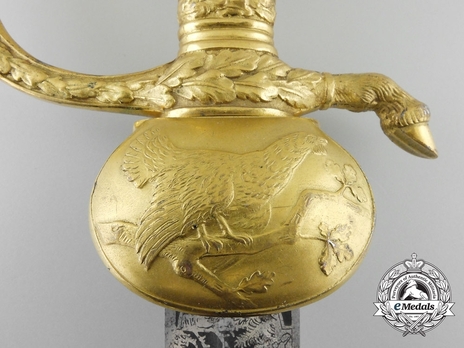
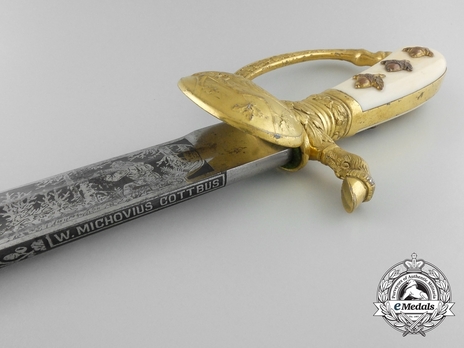
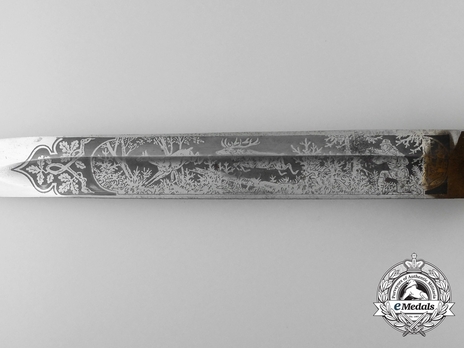
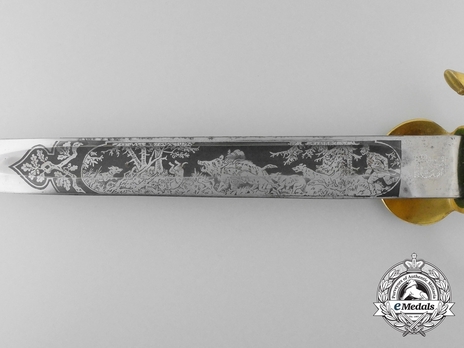
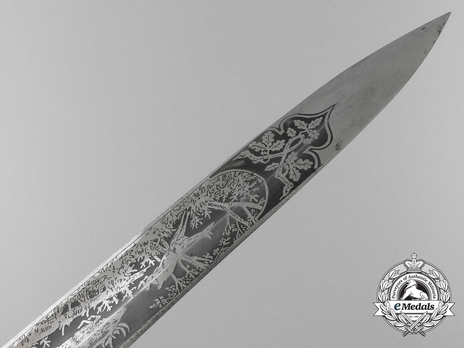
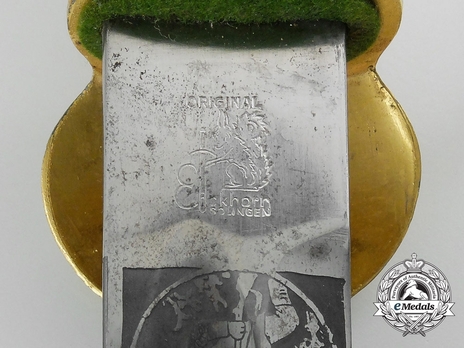
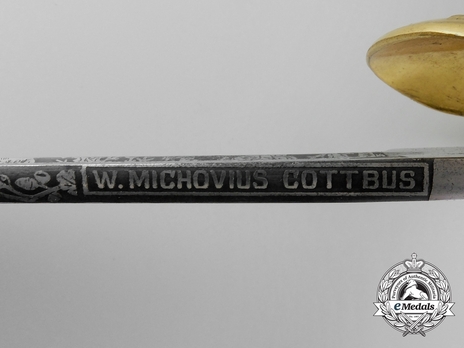
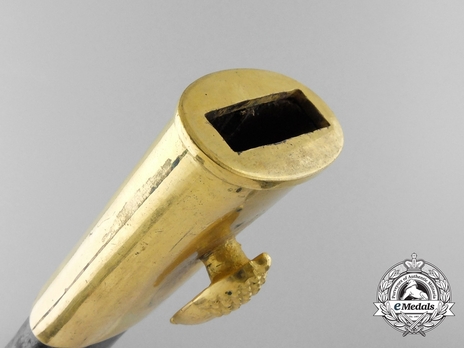
Estimated market value:
A short style Forestry Cutlass, a fine quality Deluxe model produced by Eickhorn; constructed of high quality fire gilded brass-based mounts (retaining over 95% of the original gilded finish). The “D” guard begins and ends in the shape of deer hooves, standard on these hunting cutlasses, and really finely detailed. The inside area and crossguard area feature overlapping and finely detailed oak leaves; the ferrule is constructed as a part of the crossguard, with same pattern of overlapping oak leaves. Below the crossguard is the deluxe polished clamshell, centering the capercaillie bird, being the largest member of the grouse family, sitting on an oak branch. The grip plates is made of horn, with three well-detailed acorns riveted on each side; in excellent condition, no cracks or chipping. The scabbard shell is made of black thick leather,while the reverse of the scabbard is sewn up the center. The mounts are of constructed of gilded brass with scalloped edges, while the lower scabbard mount has an engraved deer motive on obverse. The triple etched blade is also in excellent condition. This blade is about 10 ½ inches long and has about 100% of the original frosting in the backgrounds of the etched hunting scenes. Further, along the spine of the blade is the distributors/retailer's mark "W.MICHOVIUS COTTBUS" - Cottbus being the only known distributor of Eickhorn Forestry daggers. Stamped into reverse blade is the logo of the maker "Carl Eickhorn", nicely stamped. This circa 1930's manufactured cutlass is in excellent condition, exhibits slight wear and use, and of excellent quality manufacture.
Like every organisation during the Third Reich, forestry was placed under the control of the NSDAP. The Reichsforstamt (National Forestry Office) was created in 1934 to replace the regional forestry departments that had existed prior to this date. The goals of the Reichsforstamt were to extract economic value in the form of timber from the forests for the German industry, as well as preserve nature and natural monuments for the people as a part of German culture.
A sub-department for professional hunters employed by the government was created. Hunting matters had formerly been a part of the Ministry for Food and Agriculture, but were now placed under the influence of the Reichsforstamt.
Private forestry matters were placed under the care of the Reichsnährstand (National Nutritional Estate) in 1941.
The Reichsforstamt was headed by Luftwaffe leader Hermann Göring as Reichsforstmeister (minister of forestry).
The Reichsbund Deutsche Jägerschaft (National Society of German Hunters) was founded in 1934 as a statutory corporation for non-professional hunters. All existing hunting societies were disbanded and memberships transferred to the Deutsche Jägerschaft. Membership was mandatory for everyone with a hunting license.
Hermann Göring led the organisation as Reichsjägermeister (minister of hunting).
The Reichsforstschutz or Forstschutzkommando (Forestry Protection Service), in 1943 renamed to Forstschutzkorps (Forestry Protection Corps), was a paramilitary force instituted in February of 1940 in the General Government (occupied Poland). Made up of German forestry officials and ethnic Germans from Poland, the Forstschutz was tasked with regular forestry duties, as well as patrolling and protecting woodlands to keep them from being used by the Polish resistance. In 1942, Forstschutz personnel was also stationed in the Eastern European occupied territories where their work was heavily focused on anti-partisan operations.
Very little is known about the Forstschutz organisation today, and all items related to it are exceedingly rare.
The Forestry hunting cutlass is of the same design as that of hunting weapons worn during German Imperial and Weimar Republic times. This weapon is also known as “Hirschfänger” (literally stag catcher). There is a large number of variations of this weapon since there were no strict regulations. As well, the blade length differed considerably between manufacturers.
It commonly has gold-coloured metal fittings, a knuckle bow, and a clamshell on a crossguard in the style of deer hooves. The version for the lower ranked operational officers has a staghorn grip, while the higher ranked administrative officials used a version with a white celluloid or ivory grip. On the grip are three gold-coloured metal acorns. The blade generally features etchings of hunting motifs. The scabbard was made of black leather with gold-coloured metal fittings, with a protruding acorn pattern lug at the top.
A swastika, either on its own or as part of a national eagle emblem, can sometimes be found on a hunting cutlass, but this is an extremely rare occurrence.
The cutlass was attached by means of a brown or black leather frog and could be worn with a green portepee for the lower ranks. Higher ranks wore silver-coloured portepees with green stripes and highest ranks wore gold-coloured portepees with green stripes.
The hunting cutlass is rare.

Comments
Sign in to comment and reply.


Scroll Top